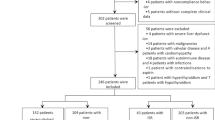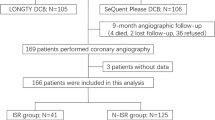Abstract
Background
This study aimed to investigate the occurrence and predictive factors of restenosis in coronary heart disease (CHD) patients underwent percutaneous coronary intervention (PCI) with sirolimus-eluting stent (SES).
Methods
Demographic data, clinical features, and laboratory tests of 398 CHD patients underwent PCI with SES were retrospectively reviewed. Coronary angiography was performed to evaluate coronary stenosis before PCI and in-stent restenosis at 1-year follow-up.
Results
There were 37 (9.3%) patients suffered restenosis, but 361 (90.7%) patients did not develop restenosis at 1-year follow-up. Demographic characteristic (age), cardiovascular risk factors (hypertension and hyperuricemia), biochemical indexes (fasting blood-glucose, total cholesterol, low density lipoprotein cholesterol (LDL-C) and high-sensitivity C-reactive protein (HsCRP)), cardiac function index (cardiac troponin I), lesion features (multivessel artery lesions, target lesion at left circumflex artery (LCX), two target lesions and length of target lesion), and operation procedure (length of stent) were correlated with higher restenosis risk. Moreover, age, hypertension, diabetes mellitus, LDL-C, HsCRP, and target lesion at LCX were independent predictive factors for raised restenosis risk. Based on these independent predictive factors, we established a restenosis risk prediction model, and receiver-operating characteristic curves displayed that this model exhibited an excellent predictive value for higher restenosis risk (areas under the curve 0.953 (95% CI 0.926–0.981)).
Conclusion
Our findings provide a new insight into the prediction for restenosis in CHD patients underwent PCI with SES.


Similar content being viewed by others
References
Piccolo R, Giustino G, Mehran R, Windecker S (2015) Stable coronary artery disease: revascularisation and invasive strategies. Lancet 386(9994):702–713
Sanchis-Gomar F, Perez-Quilis C, Leischik R, Lucia A (2016) Epidemiology of coronary heart disease and acute coronary syndrome. Ann Transl Med 4(13):256
Zheng X, Zheng Y, Ma J, Zhang M, Zhang Y, Liu X, Chen L, Yang Q, Sun Y, Wu J, Yu B (2019) Effect of exercise-based cardiac rehabilitation on anxiety and depression in patients with myocardial infarction: a systematic review and meta-analysis. Heart Lung 48(1):1–7
Beatty AL, Doll JA, Schopfer DW, Maynard C, Plomondon ME, Shen H, Whooley MA (2018) Cardiac rehabilitation participation and mortality after percutaneous coronary intervention: insights from the veterans affairs clinical assessment, reporting, and tracking program. J Am Heart Assoc 7(19):e010010
Tian Y, Deng P, Li B, Wang J, Li J, Huang Y, Zheng Y (2019) Treatment models of cardiac rehabilitation in patients with coronary heart disease and related factors affecting patient compliance. Rev Cardiovasc Med 20(1):27–33
Nazneen F, Herzog G, Arrigan DW, Caplice N, Benvenuto P, Galvin P, Thompson M (2012) Surface chemical and physical modification in stent technology for the treatment of coronary artery disease. J Biomed Mater Res B Appl Biomater 100(7):1989–2014
Arafat M, Fouladian P, Blencowe A, Albrecht H, Song Y, Garg S (2019) Drug-eluting non-vascular stents for localised drug targeting in obstructive gastrointestinal cancers. J Control Release 308:209–231
Zahn R, Hamm CW, Schneider S, Zeymer U, Richardt G, Kelm M, Levenson B, Bonzel T, Tebbe U, Sabin G, Nienaber CA, Pfannebecker T, Senges J, German Cypher Stent R (2007) The Sirolimus-eluting coronary stent in daily routine practice in Germany: trends in indications over the years. Results from the prospective multi-centre German Cypher Stent registry. Clin Res Cardiol 96(8):548–556
Mazin I, Paul G, Asher E (2019) Neoatherosclerosis - from basic concept to clinical implication. Thromb Res 178:12–16
Ray GM, Nawarskas JJ, Frishman WH (2006) The paclitaxel-eluting stent in percutaneous coronary intervention: part II. Comparison with the sirolimus-eluting stent, economics, and unanswered questions. Cardiol Rev 14(3):143–150
Yates DJ, Savage ML, Walters DL, Raffel OC (2016) Retrospective study of first-generation drug-eluting stents, second-generation drug-eluting stents and non-drug eluting stent methods in the treatment of native vessel in-stent restenosis in real-world clinical practice. Heart Lung Circ 25(4):342–351
Farooq V, Gogas BD, Serruys PW (2011) Restenosis: delineating the numerous causes of drug-eluting stent restenosis. Circ Cardiovasc Interv 4(2):195–205
Xiu WJ, Yang HT, Zheng YY, Ma YT, Xie X (2018) Drug-eluting balloons versus second-generation drug-eluting stents for treating in-stent restenosis in coronary heart disease after PCI: a meta-analysis. Cardiol Res Pract 2018:7658145
Kastrati A, Dibra A, Mehilli J, Mayer S, Pinieck S, Pache J, Dirschinger J, Schomig A (2006) Predictive factors of restenosis after coronary implantation of sirolimus- or paclitaxel-eluting stents. Circulation 113(19):2293–2300
Zhao LP, Xu WT, Wang L, Li H, Shao CL, Gu HB, Chan SP, Xu HF, Yang XJ (2015) Influence of insulin resistance on in-stent restenosis in patients undergoing coronary drug-eluting stent implantation after long-term angiographic follow-up. Coron Artery Dis 26(1):5–10
Wu Y, Fu X (2019) Comprehensive analysis of predictive factors for rapid angiographic stenotic progression and restenosis risk in coronary artery disease patients underwent percutaneous coronary intervention with drug-eluting stents implantation. J Clin Lab Anal 33(2):e22666
Qian H, Luo Z, Xiao C, Chen J, Li D, Xu H, He P, Zhou X, Zhang T, Min X (2018) Red cell distribution width in coronary heart disease: prediction of restenosis and its relationship with inflammatory markers and lipids. Postgrad Med J 94(1115):489–494
Obata JE, Nakamura T, Kitta Y, Saito Y, Sano K, Fujioka D, Kawabata K, Kugiyama K (2013) In-stent restenosis is inhibited in a bare metal stent implanted distal to a sirolimus-eluting stent to treat a long de novo coronary lesion with small distal vessel diameter. Catheter Cardiovasc Interv 82(6):E777–E787
Levine GN, Bates ER, Blankenship JC, Bailey SR, Bittl JA, Cercek B, Chambers CE, Ellis SG, Guyton RA, Hollenberg SM, Khot UN, Lange RA, Mauri L, Mehran R, Moussa ID, Mukherjee D, Nallamothu BK, Ting HH, American College of Cardiology F, American Heart Association Task Force on Practice G, Society for Cardiovascular A, Interventions (2013) 2011 ACCF/AHA/SCAI guideline for percutaneous coronary intervention: a report of the American College of Cardiology Foundation/American Heart Association Task Force on Practice Guidelines and the Society for Cardiovascular Angiography and Interventions. Catheter Cardiovasc Interv 82(4):E266–E355
Bruining N, Sabate M, de Feyter PJ, Kay IP, Ligthart J, Disco C, Kutryk MJ, Roelandt JR, Serruys PW (1999) Quantitative measurements of in-stent restenosis: a comparison between quantitative coronary ultrasound and quantitative coronary angiography. Catheter Cardiovasc Interv 48(2):133–142
Haase J, Escaned J, van Swijndregt EM, Ozaki Y, Gronenschild E, Slager CJ, Serruys PW (1993) Experimental validation of geometric and densitometric coronary measurements on the new generation Cardiovascular Angiography Analysis System (CAAS II). Catheter Cardiovasc Diagn 30(2):104–114
Siontis GC, Piccolo R, Praz F, Valgimigli M, Raber L, Mavridis D, Juni P, Windecker S (2016) Percutaneous coronary interventions for the treatment of stenoses in small coronary arteries: a network meta-analysis. JACC Cardiovasc Interv 9(13):1324–1334
Finn AV, Nakazawa G, Joner M, Kolodgie FD, Mont EK, Gold HK, Virmani R (2007) Vascular responses to drug eluting stents: importance of delayed healing. Arterioscler Thromb Vasc Biol 27(7):1500–1510
Nakazawa G, Nakano M, Otsuka F, Wilcox JN, Melder R, Pruitt S, Kolodgie FD, Virmani R (2011) Evaluation of polymer-based comparator drug-eluting stents using a rabbit model of iliac artery atherosclerosis. Circ Cardiovasc Interv 4(1):38–46
Park HJ, Kim HY, Lee JM, Choi YS, Park CS, Kim DB, Her SH, Koh YS, Park MW, Kwon BJ, Kim PJ, Chang K, Chung WS, Seung KB (2012) Randomized comparison of the efficacy and safety of zotarolimus-eluting stents vs. sirolimus-eluting stents for percutaneous coronary intervention in chronic total occlusion--CAtholic Total Occlusion Study (CATOS) trial. Circ J 76(4):868–875
Ge L, Iakovou I, Cosgrave J, Chieffo A, Montorfano M, Michev I, Airoldi F, Carlino M, Melzi G, Sangiorgi GM, Corvaja N, Colombo A (2005) Immediate and mid-term outcomes of sirolimus-eluting stent implantation for chronic total occlusions. Eur Heart J 26(11):1056–1062
Chatani K, Muramatsu T, Tsukahara R, Ito Y, Ishimori H, Hirano K, Nakano M, Yamawaki M, Araki M, Sakurai M, Iuchi K, Nozawa T, Inoue H (2009) Predictive factors of re-restenosis after repeated sirolimus-eluting stent implantation for SES restenosis and clinical outcomes after percutaneous coronary intervention for SES restenosis. J Interv Cardiol 22(4):354–361
Ishii H, Toriyama T, Aoyama T, Takahashi H, Amano T, Hayashi M, Tanaka M, Kawamura Y, Yasuda Y, Yuzawa Y, Maruyama S, Matsuo S, Matsubara T, Murohara T (2009) Prognostic values of C-reactive protein levels on clinical outcome after implantation of sirolimus-eluting stents in patients on hemodialysis. Circ Cardiovasc Interv 2(6):513–518
Asamasu-Sato S, Mita M, Ogawa R, Isaka M, Saito M (2007) Analysis of clinical factors that influence re-stenosis after percutaneous coronary stenting. Yakugaku Zasshi 127(8):1309–1315
Mohan S, Dhall A (2010) A comparative study of restenosis rates in bare metal and drug-eluting stents. Int J Angiol 19(2):e66–e72
Aronson D (2002) Potential role of advanced glycosylation end products in promoting restenosis in diabetes and renal failure. Med Hypotheses 59(3):297–301
Ping S, Liu S, Zhou Y, Li Z, Li Y, Liu K, Bardeesi AS, Wang L, Chen J, Deng L, Wang J, Wang H, Chen D, Zhang Z, Sheng P, Li C (2017) Protein disulfide isomerase-mediated apoptosis and proliferation of vascular smooth muscle cells induced by mechanical stress and advanced glycosylation end products result in diabetic mouse vein graft atherosclerosis. Cell Death Dis 8(5):e2818
Li C, Shen Y, Xu R, Dai Y, Chang S, Lu H, Dong Z, Deng J, Qian J, Ge J (2018) Evaluation of Preprocedural laboratory parameters as predictors of drug-eluting stent restenosis in coronary chronic total occlusion lesions. Angiology:3319717752245
Li JJ, Yan HB, Xiang XP, Qin XW, Zhang CY (2009) Comparison of changes in early inflammatory markers between sirolimus- and paclitaxel-eluting stent implantation. Cardiovasc Drugs Ther 23(2):137–143
Nakazawa KR, Wengerter SP, Power JR, Lookstein RA, Tadros RO, Ting W, Faries PL, Vouyouka AG (2017) Preoperative inflammatory status as a predictor of primary patency after femoropopliteal stent implantation. J Vasc Surg 66(1):151–159
Naganuma T, Chieffo A, Basavarajaiah S, Takagi K, Costopoulos C, Latib A, Carlino M, Montorfano M, Bernelli C, Nakamura S, Colombo A (2013) Single-stent crossover technique from distal unprotected left main coronary artery to the left circumflex artery. Catheter Cardiovasc Interv 82(5):757–764
Author information
Authors and Affiliations
Corresponding author
Ethics declarations
This study was approved by the Institutional Review Board of The Second Hospital of Hebei Medical University, and the written informed consents were provided by patients or their guardians.
Conflict of interest
The authors declare that they have no conflict of interest.
Additional information
Publisher’s note
Springer Nature remains neutral with regard to jurisdictional claims in published maps and institutional affiliations.
Rights and permissions
About this article
Cite this article
Zhao, J., Wang, X., Wang, H. et al. Occurrence and predictive factors of restenosis in coronary heart disease patients underwent sirolimus-eluting stent implantation. Ir J Med Sci 189, 907–915 (2020). https://doi.org/10.1007/s11845-020-02176-9
Received:
Accepted:
Published:
Issue Date:
DOI: https://doi.org/10.1007/s11845-020-02176-9




